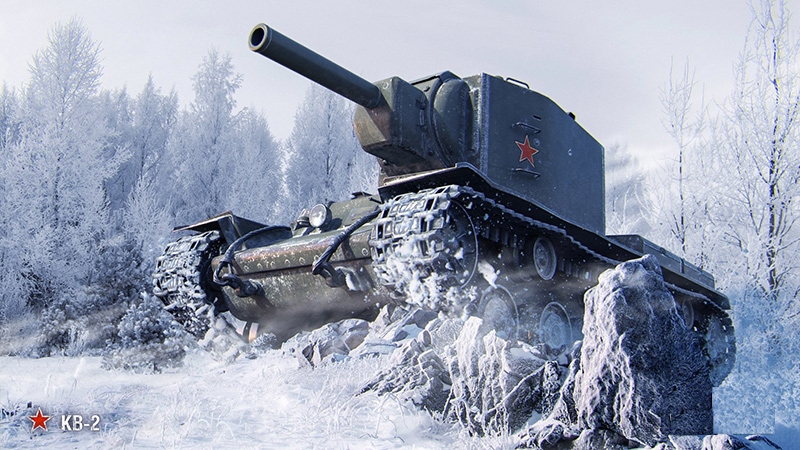
KV-2 - Soviet heavy tank assault of the initial period of the Great Patriotic War. Abbreviation HF means "Kliment Voroshilov" - the official name of the series of Soviet heavy tanks release 1939-1943 gg., named after a hero of the Civil War in Russia, military and politician Kliment Voroshilov. Originally it was called "HF with a big tower".
KV-2 – video
This machine was developed by the Leningrad Kirov factory design bureau (LCO) in January 1940 , in connection with the urgent need of the Workers 'and Peasants' Red Army (RKKA) in a well protected tank with powerful weapons to fight the fortifications of the Mannerheim Line at the time of the Soviet-Finnish war of 1939-1940.
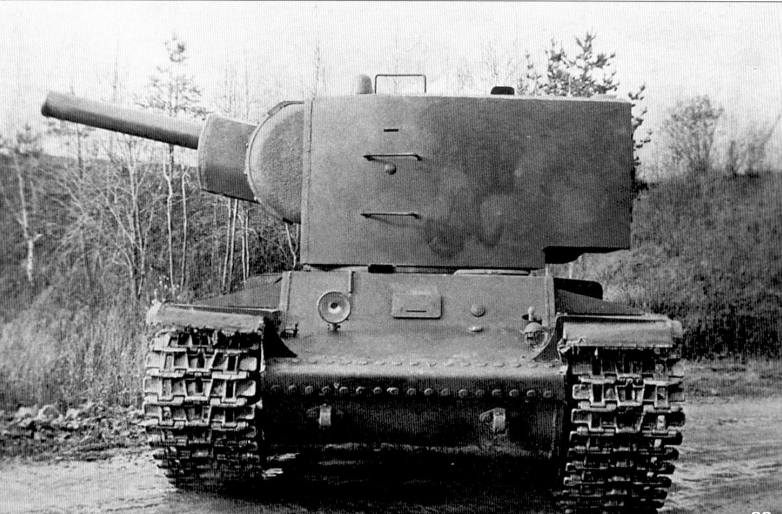
Design
Armored tank body welded from rolled armor plate thickness 75, 40, 30 and 20 mm. Armor protection of ravnoprochnaya (armor plate with a thickness, different from 75 mm, used only for horizontal machine booking), protivosnaryadnym. Armor plate, the frontal part of the machine installed at rational angles. Thus the first sample-2 HF tanks different from mass-produced cars shape and configuration of the tower gun mantlet. Tower serial HF-2 was produced in two versions: Initial installation of the MT-1 and later "reduced" tower smaller mass. Externally, these two types of towers are easily distinguishable by their front extremity: installation of MT-1 is inclined zygomatic armor plates, and "reduced" version - vertical. Both versions towers welded from rolled armor plates, their armor thickness equaled 75 mm. "Reduced" modification of the tower next to his stern door had a ball mount machine gun DT. The tower was placed on the shoulder straps with a diameter 1535 mm armored fighting compartment roof and fixed grippers avoid stalling under strong roll or roll-over of the tank. Azimuth circle tower is marked with the thousandths firing from covered positions.
The driver is centered in front of the tank armored housing, on his left hand were workplace-wireless operator. Four crew members were located in the tower: left of the guns were gunner and loader, and on the right - the tank commander and assistant loader. Planting and crew made out through the stern door of the tower and two round hatch: one in place in the tower and one commander in the housing in place arrow-radio operator. The housing also had of the bottom hatch for emergency escape of tank crews and a number of hatches, hatches and technological openings for loading ammunition, access to fuel tanks, other nodes and aggregates machines.
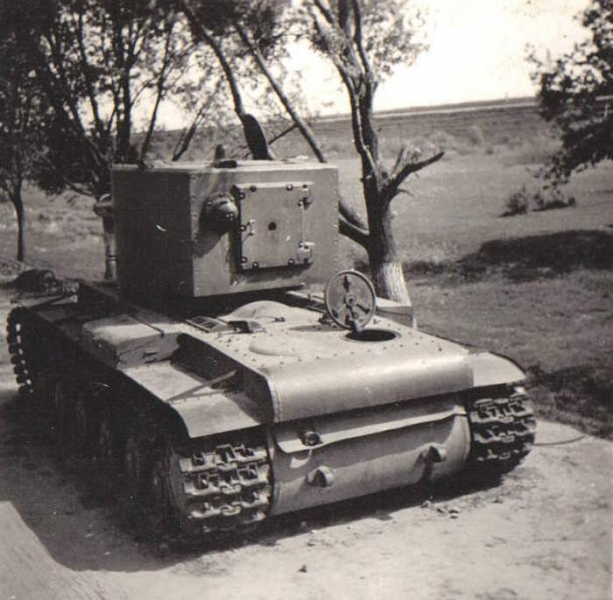
Engine
HF-2 was equipped with a four-stroke V-shaped 12-cylinder diesel engine of V-2K power 500 l. from. (382 kW) at 1800 rev / min, subsequently brought to the engine power 600 l. from. (441 kW). Starting the engine ensured the starter ST-700 output 15 l. from. (11 kW) or compressed air capacity of the two tanks 5 l in the combat engine room. HF-2 was a dense arrangement, at which the main fuel tanks 600-615 liter volume and placed in a combat, and engine-transmission compartment.
Transmission
KV-2 equipped with a manual transmission, which included:
– multidisc main clutch "steel Ferodo" dry friction;
– five-speed gearbox tractor type;
– two multiple-disk friction clutch board "steel on steel";
– two onboard planetary gear.
– tape floating brake
All transmission control actuators - mechanical. When operating in the army the greatest number of complaints and claims against manufacturer defects caused it and work extremely unreliable transmission group, especially in congested tanks KV issue of wartime. Virtually all reputable published sources is recognized as one of the most significant shortcomings of tanks and KV series machines on the basis of its low overall reliability of the transmission as a whole.
Chassis
Suspension machines - individual torsion bar with internal shock absorbers for each of the 6 gable of track rollers on each side of small diameter. Next to each track roller welded to the hull of travel stops suspension balancers. Driving wheels with removable gear rings lantern meshing located behind, and sloths - the front. The upper branch tracks supported by three small rubberized supporting rollers on each side. Mechanism track tension - screw; each caterpillar consisted of 86-90 odnogrebnevyh shoe width 700 mm increments 160 mm.
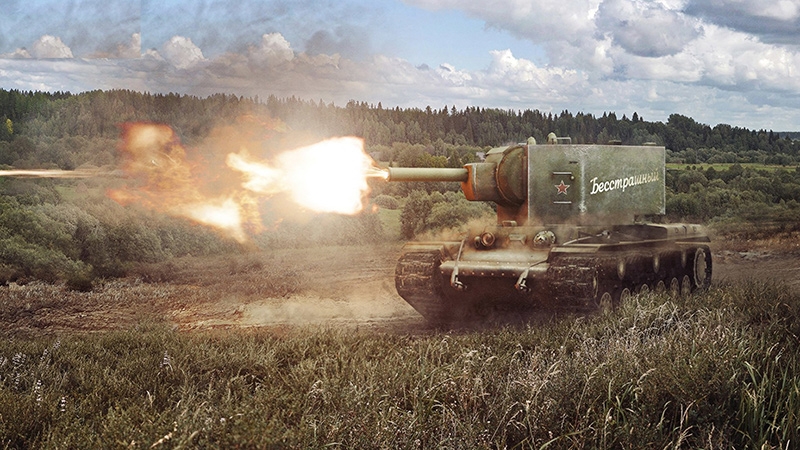
electrics
Wiring in the tank KV-2 was a single-wire, the second wire served hull of the machine. The exception was the emergency lighting circuit, which was a two-wire. power sources (operating voltage 24 AT) It was GT-4563A generator with relay control PPA-24 power 1 kW and four series-connected rechargeable batteries 6 of the brand-STE-128. electrical consumers included:
– electric turret;
– exterior and interior car lighting, lighting equipment scopes and scales of measuring instruments;
– External sound and alarm circuit from the landing to the carriage of the machine;
– instrumentations (ammeter and voltmeter);
– means of communication - the radio station and tank intercom;
– electrical motor group - the starter ST-700, start relay RS-371 or RS-400, etc.. d.
Surveillance and sights
Total visibility of the tank KV-2 still in 1940 It was estimated in a memo L. Mehlis by military engineer Kalivodom as extremely poor. Commander of the machine had only one viewing device in the tower - panorama PTK. The driver in the battle waged observed through an observation unit with triplex, which protects the armored shutter. This observation device installed in an armored hatch-stopper for the frontal armor plate in the longitudinal axial line of the machine. In a quiet environment, this hatch-stopper can be pushed forward, providing a driver-mechanic more convenient immediate review of his workplace.
For firing the KV-2 was equipped with two cannon sights - telescopic TOD-9 for direct fire and periscope PT-9 shooting from the closed position. Head periscope sight was protected by an armored hood special. To be able to fire in a night-time sight scales were lighting devices. ESP and aft guns DT could be equipped with a PU scope of a sniper rifle with a threefold increase.
Means of communication
communication means includes a shortwave radio 71-TC-3 and the internal intercom TPU-4-Bis on 4 subscriber. Radio equipped with all of the issued tanks KV-2.
Tank intercom TPU-4-Bis allowed to negotiate between the tank crew members, even in very noisy environment and the headset connect the headset (headphones and laringophones) to the radio for external communication.
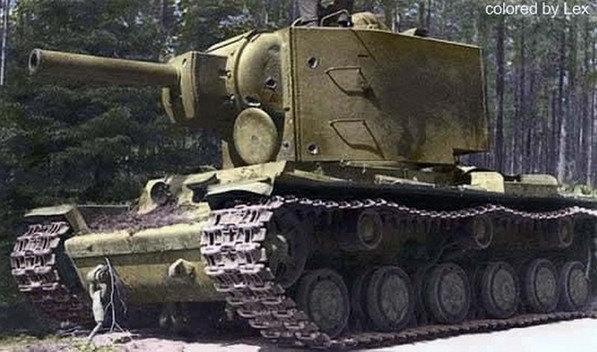
weaponry
The tank HF-2 was installed 152 mm Tank howitzer arr. 1938/40 gg. (M-10T), Tank howitzer sample version field 1938 of the year (M-10). Howitzer M-10T mounted on the trunnions of the tower and was completely equilibrated, however tower tool M-10T was not equilibrated: its center of gravity is not located on the geometric axis of rotation. As a result, regular rotation of the electric motor drive of the tower even with a small roll of the machine could not cope with its task. Howitzer M-10T vertical had angles interference from -3 to + 18 °, a fixed position of the tower she could be induced in a small traverse sector (t. n. "Jewelry" leveling). The shot produced by manual mechanical shutter.
Ammunition gun was 36 rounds of separate loading. shots (shells and propellant charges in sleeves) They fit into the tower and along both sides of the fighting compartment. Compared with a wide assortment of ammunition 152-mm M-10 howitzer ammunition regular HF-2 was limited to only one type of ammunition:
– high-explosive fragmentation grenade steel howitzer RP-530 weight 40 kg (mass of explosives - TNT or Amatol - from 5,47 to 6,86 kg) and a special charge, derived from full-charge towed F-536 M-10 howitzer removing several equilibrium beams powder.
However, in practice, in an atmosphere of summer chaos 1941 year due to the desperate situation with security HF-2 position on the state of the ammunition used all kinds of 152-mm howitzer shells, suitable to M-10 howitzer, who only managed to find (in some military districts was at the level of completeness 10 %, other staff of ammunition for the KV-2 was not at all). That is, they could be used as a concrete-piercing shells G-530, and howitzer fragmentation grenades stalistogo iron O-530A, carcass, old high-explosive grenades, shrapnely. Shooting on a full charge is strictly prohibited, since because of the high returns and rollback could jam the tower, shake could suffer components and assemblies engine-transmission group. For the latter reason the shooting was permitted only with places, which further increased the vulnerability of the tank in combat. Armor piercing ammunition Panzer Howitzer M-10T in the available sources are not given, but in practice it was on forces to penetrate the armor of any armored vehicle in the Wehrmacht 1941 and early 1942 of the year. Armor piercing shell sea polubroneboynogo arr. 1915/28 gg. was 72 mm steel distances 1500 meters at an angle 60 degrees.
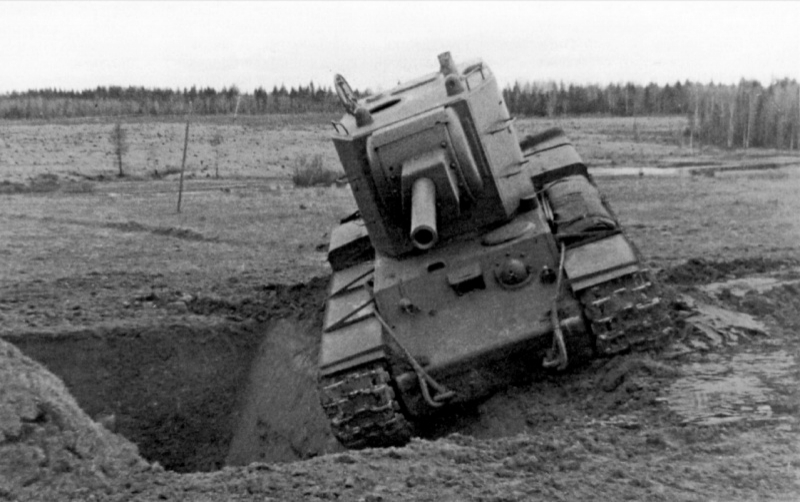
Soviet heavy tank KV-2 (the serial number B-9633) on display komnachsostavu the Red Army on the ground in Moscow Kubinka. The machine is embodied to overcome anti-tank ditch.
In batch tank KV-2 were installed three 7.62mm gun DT: paired with a weapon, as well as foreign exchange and stern ball mount. Ammunition for all diesel fuel was 3087 rounds. These guns mounted in such a way, that they can be removed, if necessary, with mounts and used outside of the tank. Also for self-defense crew I had several hand grenades F-1 and sometimes supplied with a gun for firing flares.
In the initial period of war, the KV-2 is easily destroyed every enemy tank, and almost always with impunity, as his armor is not penetrated nor shells tank shells, no standard anti-tank artillery. Effectively deal with the KV-2 could just were not designed for this purpose anti-aircraft guns Flak 18/36/37.
Production

In February 1940 , the KV-2 was officially adopted by the Red Army and serially manufactured at LB before July 1941 of the year. The reason for withdrawing from the production served as the beginning of the Great Patriotic War. Total built LB 204 the KV-2, which are actively used in combat 1941 year and at the same time were almost all lost.
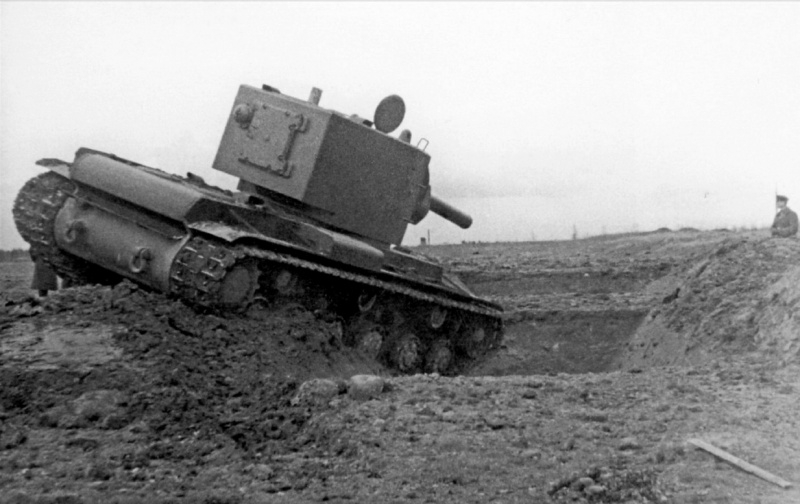
combat application
Factory testing of the new tank will not last long. Already 17 February both prototypes went to the front. The information needed to improve was collected during the military trials. In particular, admissible range of ammunition has been expanded - namely strengthening steel by Mannerheim line objects, thanks to which "the tank with a big tower" began to shoot projectiles betonoboynymi. Also, the military made a number of proposals regarding the layout of the new tower. In accordance with these recommendations, in the second half 1940 year SKB-2 engineers have finalized its shape. Firstly, alteration undergone its dimensions. Updated turret had lower height and denotes the index of the MT-2. At the same time it changed the shape of the front and side panels. For ease of assembly of the tower became rectangular forehead, rather than a trapezoidal, like before. Also redesigned the mask tools and introduced a number of smaller improvements.
Modified tank turret with MT-2 is the, that wanted to get the military. Now armed armored vehicles had the proper power and ease of use. With regard to the level of protection, the book KV tanks from the beginning of their battle performance received the highest honors. So, After fighting on the forehead, sides and towers experienced "tanks with a big tower" has dozens of dents from enemy shells. In just a few months of combat tests, none of them have not been able to break through 75 mm of rolled homogenous armor. As an example of the power of weapons and the level of protection of the new machine can quote tankman E. F. Glushak:
– Obstacles on the Mannerheim Line had made thorough. Before us towered the three rows of huge granite dragon's teeth. And yet for, to make the passage of 6-8 meters wide, It took us only five shots concrete-shells. While hacking dragon's teeth, We are continuously bombarded enemy. Dot we quickly spotted, and then two shots completely destroyed it. When they left the battlefield, We counted on the armor 48 dents, but no holes.
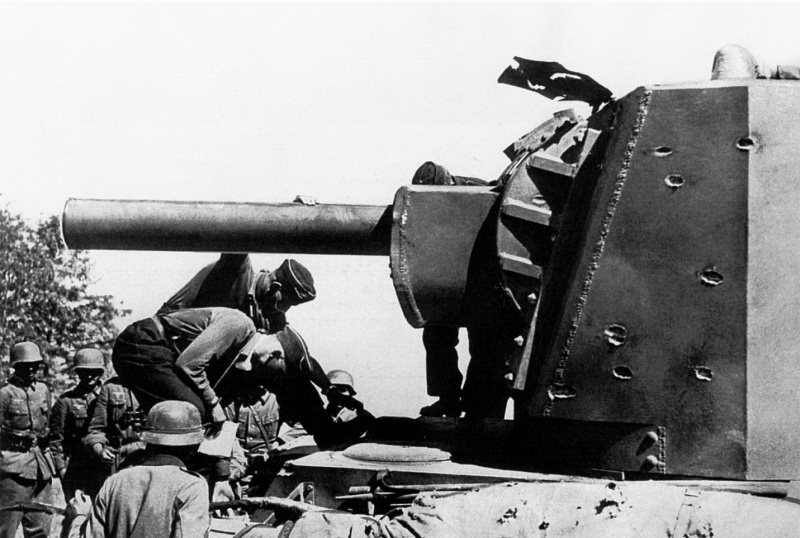
German soldiers in the Soviet heavy tank KV-2 with tower MT-1, downed in the Lithuanian town in Shaukotas 30 kilometrah RASEINIAI. Machine Release July and August 1940 the year of the 2nd Armored Division 3rd Mechanized Corps of the 11th Army of the North-Western Front. On the tower seen from the results numerous traces 37 mm armor piercing projectiles.
The totality of protection, weapons and mobility influenced the decision of the People's Commissariat of Defense. At the beginning 1941 , the new tank was accepted for service under the name KV-2. Serial production was deployed in the Leningrad Kirov factory. KV-2 was produced until October 1941 of the year. In the first months of the war the issue of heavy tanks gradually decreased. The reason for this were several factors: the complexity and labor intensity of production, the plight of the industry, plants need evacuation etc. The exact number of tanks manufactured HF-2 raises questions. the figure given most often in 330-340 machines. However, several sources indicated by the fact, that the Perm plant №172 managed to make only a hundred of suspension systems for howitzers. From this it is concluded appropriate amount collected tanks.
Despite the relatively small number of tanks manufactured HF-2, in the Great Patriotic War, they created a furor. His 152-mm shells heavy tanks confidently struck all available at that time the German armor. booking, in its turn, enough to protect the vast majority of guns. More or less normal to struggle with "Klim Voroshilov" second model could only 88-mm anti-aircraft gun. However, the duel tank and anti-aircraft gunners had no pre-intuitive results: due to a larger caliber tank guns could destroy calculation, without entering into a guaranteed kill zone. In addition, the tankers were placed for the full armor plates, and not bulletproof shield gun. Generally, KV-1 and KV-2 was a formidable force, which was worth to be afraid. However, some of the nuances of the application, logistics, etc.. led to sad results.
As examples of failures of new tanks is often cited 4th Panzer Division. For the first two weeks of World War II, it has lost the connection 22 the KV-2. However, only five of them were hit by enemy. The others due to lack of fuel or spare parts were abandoned or destroyed by the crew. As a matter of fact, bulk losses Soviet heavy tank exactly in non-combat incidents. Difficulties with supply and constant retreat forced tankers not repair their cars, and throw or destroy them. Nevertheless, even in such difficult conditions, Soviet tankers were delivered to the enemy a lot of problems. A striking example of this is one of the memories German officers, who served in the 1st armored division:
– Our company opened fire with 700 m. We drew closer. Soon we were already in 50-100 m different from other. But we could not succeed. Soviet tanks continued to advance, and our armor-piercing projectiles simply bounced off their armor. The tanks are kept direct fire from the 50-mm and 75-mm cannons. The KV-2 got more 70 shells, but no one was able to break through his armor. Several tanks were put out of action, When we managed to get to the caterpillar, and then shot at a close distance from the guns. Then they attacked the sappers with satchel charges.
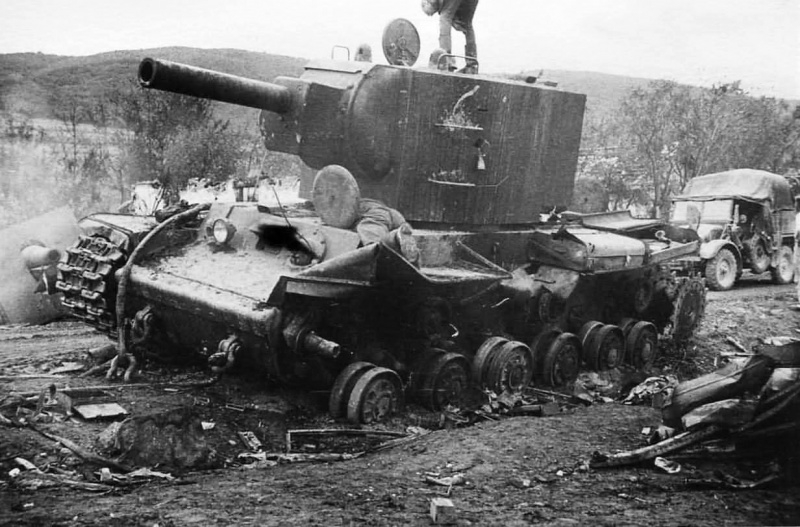
German soldiers inspect the crippled Soviet tank KV-2. Machine release of November and December 1940 year from the 8th, or the 12th Panzer divisions Southwestern Front, undermined in the village Yasenovtsy, Zolochiv district, Lviv region. In the background is the German artillery tractor Krupp-Protze Kfz.70. To the left of the tank, in a cell, Soviet 152 mm howitzer obr.1910 / 1937.
For the Germans, the meeting with the KV-2 was a real shock. Here is what wrote in his diary the commander of the 11th Tank Regiment (6-Panzer 4 Panzer Group) 25 June 1941 of the year:
– On the morning of the 2nd Battalion of the 11th Tank Regiment, together with a group of background Shekendorfa advancing along the road, avoiding the swamp right. All day often reflect the constant attacks Russian 2nd Armored Division. Unfortunately, Russian 52-ton heavy tanks showed, that they are almost insensitive to the fire of our 105-mm guns.
Several hit our 150-mm shells were also ineffective. Nevertheless, as a result of the constant attacks of tanks Pz Kpfw IV most of enemy tanks were knocked out, which allowed our units to move forward on the three kilometers west Dubysa.
group “raus” It has managed to keep its foothold, but at noon, reinforcements, the enemy counter-attacked on the left flank in the north-east at Rasenyay and routed the troops and the headquarters of the 65th Tank Battalion. At this time the Russian heavy tank cut path, connects us with a group of Raus, and the connection with this part of the missing throughout the day and then the night. Battery 88-mm anti-aircraft guns was sent to fight with the tank. The attack was a failure, as the previous bout with battery 105 mm howitzer. To all other, attempt to get close to our reconnaissance tank and burn it with incendiary bottles failed. Group could not get close enough because of heavy machine-gun fire, that led tank.
The survivors of the retreat of the Red Army tanks KV-2 had fought for several years. Beginning with 1943 of the year, of the heavy tank was revised in recovery vehicles. The thing is, that their driving performance at the time did not fully organized military, and good power engine was able to provide the evacuation padded armor. Multiple HF-2 were captured by the Wehrmacht and used for their own purposes. In the German Army, Soviet tanks were designated PzKpfw KV-II 754(r). The last of these trophies was destroyed in the 45th, during the storming of Konigsberg.
preserved specimens
The main period of life and combat operation of tanks KV-2 came in the most difficult times of the Great Patriotic War. Because of this, the tanks suffered heavy losses, Firstly, non-combat. This was one of the main reasons, that of the more than three hundred assembled tanks to the present time, only one survived. Now he is an exhibit of the Central Museum of Armed Forces. Another tank KV-2 early release (with "big tower", fully on track) in the museum of military equipment "UMMC" Mr.. Pyshma Sverdlovsk Region Museum "Battle Glory of the Urals" .Interesno, that in the Air Force Museum of the Northern Fleet (Safonovo, Murmansk region) there is another tank, similar to the HF-2. The word "like" is used here for the reason, the tank of Safonov was made to shoot the film "Tank Klim Voroshilov-2" and the basis for it was the other heavy armored vehicle - IS-2.
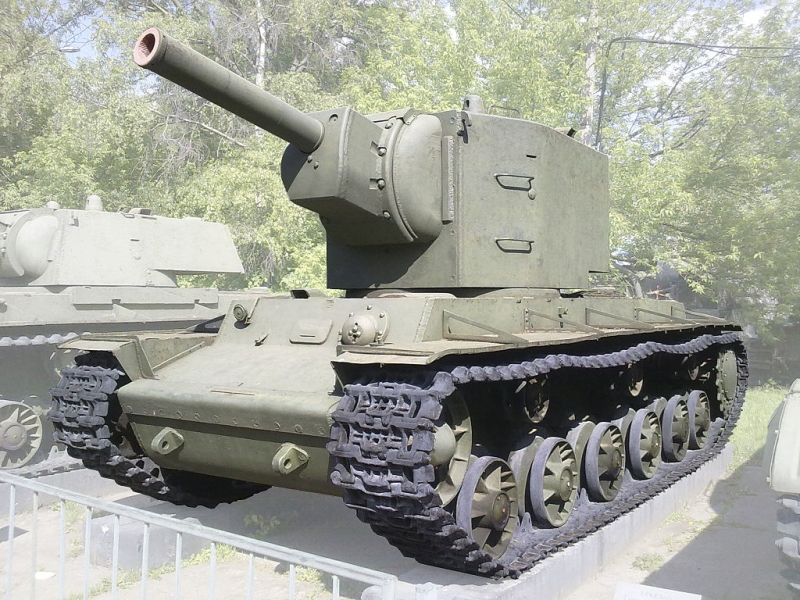
KV-2 in the Central Museum of Armed Forces
Performance characteristics of the HF-2
Crew, pers.: 6
The number of issued, PC.: 204
The layout: classical
Weight HF-2
– 52 tonnes
Dimensions KV-2
– body Length, mm: 6950
– housing width, mm: 3320
– Height, mm: 3250
– Clearance, mm: 430
Bumper KB-2
– Type broni: gomogennaya katanaya
– housing forehead (top), mm / city.: 75
– housing forehead (through), mm / city.: 70
– body board (top), mm / city.: 75
– body board (through), mm / city.: 70
– housing feed (top), mm / city.: 60—75
– housing feed (through), mm / city.: 70
– Bottom, mm: 30—40
– corps roof, mm: 30—40
– tower forehead, mm / city.: 75
– gun mantlet, mm / city.: 110
– board towers, mm / city.: 75
– tower feed, mm / city.: 75
Arming HF-2
– Caliber guns and stamp: 1 × 152 mm Tank howitzer arr. 1938/40 gg. (M-10T)
– barrel length, calibres: 24,3
– gun ammunition: 36 shells separate-case charging
– sights: telescopic sight TOD-9, periscope PT-9, commander panorama PT-K
– Shotgun: 3 × 7,62-mm DT-29
Engine HF-2
– engine's type: 12-cylinder V-shaped liquid-cooled diesel
– Engine power, l. from.: 600
Speed HF-2
– Road speed, kmh: 34
– Speed over rough terrain, kmh: 16
– Cruising on the highway, km: 250
– Cruising cross country, km: 150
– suspension type: torsionnaya
– Gradeability, city.: 36°
– to overcome the wall, m: 0,87
– trench, m: 2,7
– fording, m: 1,6
Photo HF-2
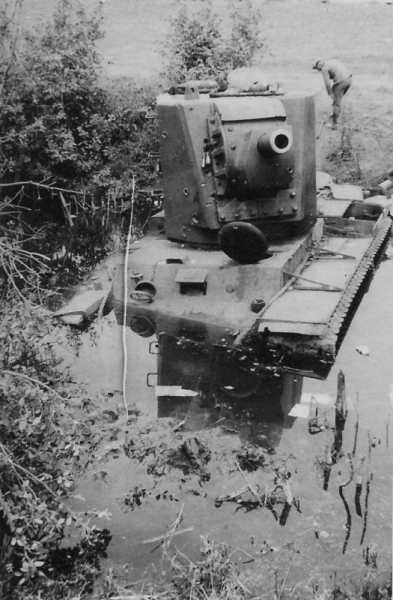
Soviet KV-2 with a tower MT-1, stuck in the river Ziedaplis (Zieduplis). Tank captured by German troops 24.06.1941 of the year. On the tower guns and mask a large number of traces of heavy ammunition of small caliber. Tanks from the 2nd Armored Division 3rd Mechanized Corps of the 11th Army of the North-Western Front. maybe, this tank was lost in Seth town area 17 km east of the town Kedainiai in Lithuania. Machine Release July and August 1940 of the year.
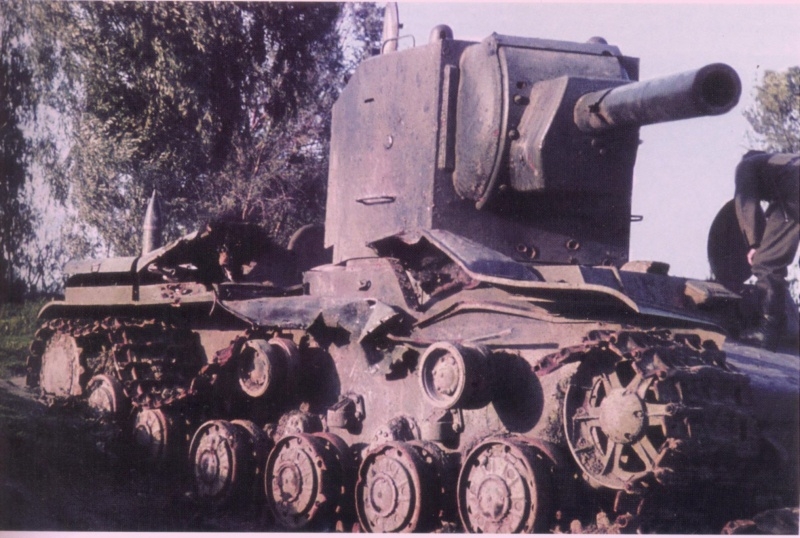
Tank KV-2 from the 6-th tank regiment 3rd Panzer 1 Mechanized Corps, padded in the battle for the city Island 5 July 1941 of the year. The serial number of the machine B-4754. The remaining acts of the cancellation of the tank KV-2 №4754 reads as follows: "The tank was hit - killed off caterpillar, which fell. Shell broken lateral reservation transmission and damaged the control rod and steering clutches, tank movement was impossible. Since damaged and burning with tanks scored travel part of the bridge, retreat was impossible because of the destroyed tank management and dump tracks, and the tank was not possible to turn. The battalion commander gave the order to get out of the tank, while he stayed in the car to remove the tank out of action. The further fate of the captain Roussanova still not known, the rest of the crew returned to the part. The battlefield was immediately occupied by the enemy, and the evacuation of the remaining cars from the battlefield became impossible. "According to HBS 'Memorial', Captain Ivan Rusanov from 6th Tank Regiment died 5 July 1941 of the year. On the other photos of this tank is seen charred body of the deceased Soviet tanker - with high probability this is I.I. Russanov.
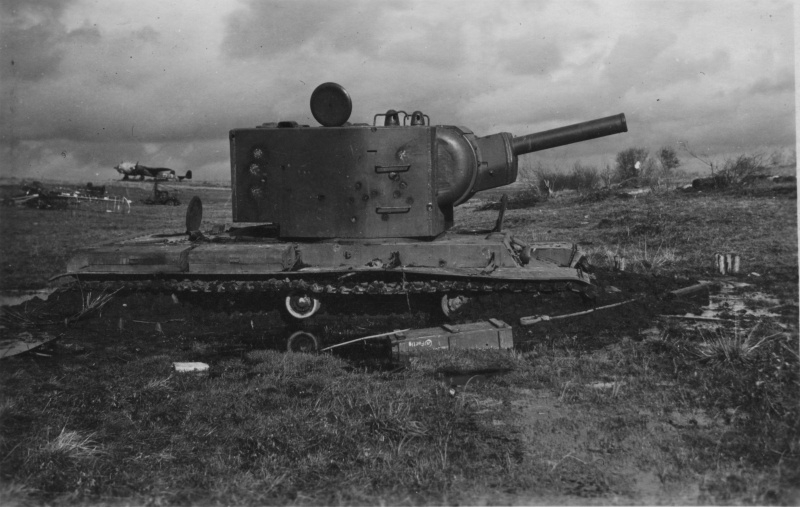
Soviet KV-2, mired in mud around Vitebsk airfield. In the background is seen the photo frame Soviet aircraft, broken airfield equipment and German bomber Do.17Z. Presumably at the pictures heavy tank KV-2 (serial number B-4712) from the 1st Tank Battalion, 28th Panzer Regiment of the 14th Panzer Division of the 7th Mechanized Corps of the Western Front. In early July, 1941 city, After repair of the engine near Smolensk, Tank took part in the defense of the city of Vitebsk: fire prevented the Germans crossing over the railway bridge, mockery 8 enemy tanks and expending 2 boekomplekta. After this battle tank was sent to replenish the filling, but the road was again thrown into battle, without shells. The crew managed to damage two tanks and one weapon the enemy, but serious damage was itself the KV - punctured radiators, damaged observation slit of the driver, as a result of contact with a projectile pierced armor tower, killing 2 crew member - Klimychev Lieutenant and Sergeant Klimov. Upon exiting the attack tank is stuck in the mud, due to lack of means of escape and a strong enemy fire to evacuate the tank could not, at the exit of the car missing two loaders.
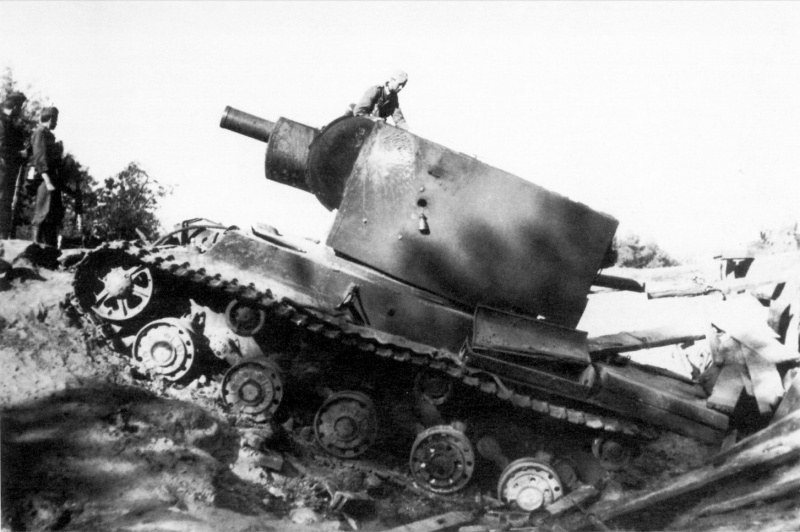
Soviet heavy tank KV-2, Rotten to the bridge in the village of Pelcha near Dubno. Machine release of November and December 1940 years of the 12th Armored Division of the 8th Mechanized Corps of the Southwestern Front. On the trail of the tower falling explosive projectile. maybe, later the tank was blown up, since there are a number of shots without a roof turret and the barrel in recoil position.
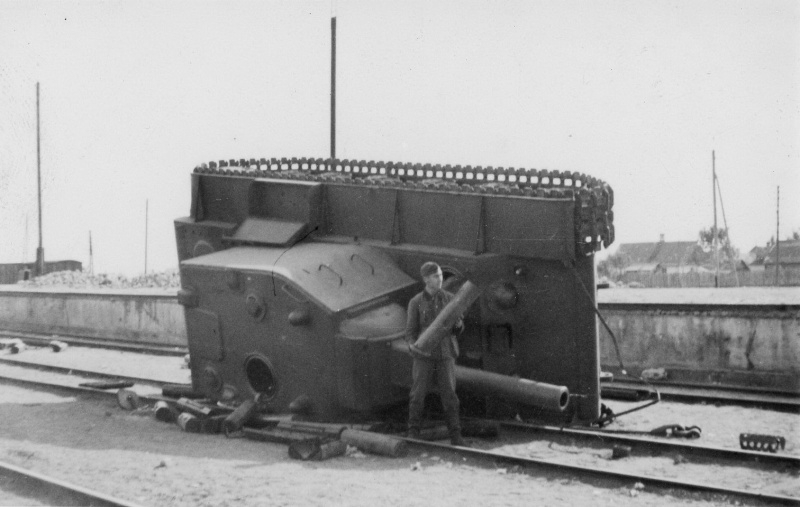
A German soldier next to the Soviet heavy tank KV-2, overturned the train station platform on Lida. Tank Release May and June 1941 of the year, intended for the 29th Armored Division of the 11th Mechanized Corps of the Western Front and was sent 17 June 1941 year from Leningrad to Grodno, among other twenty-KV-2. However, due to the outbreak of war to the place of destination the train with tanks not reached. When unloading station Lida overturned tank with the platform in the path. Further, he was removed from the track and dragged to the other captured KV-2, where he stood for quite some time.








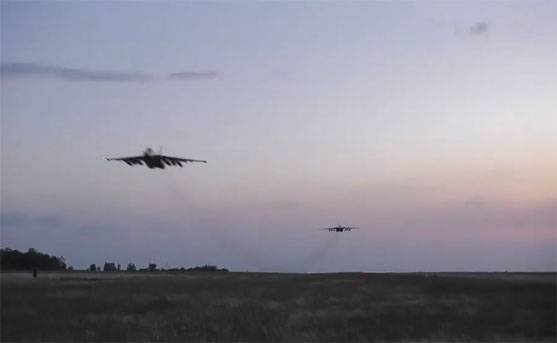



good tank